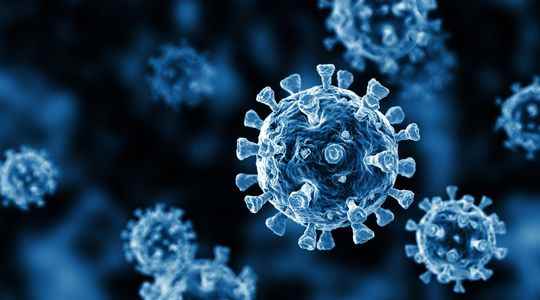In terms of health, the sky is clearing. “An improvement is observed in all regions and in all age groups”, reports in its last balance sheet published on February 17, French public health. After the fifth wave, all health indicators return to green. This Friday, the number of patients diagnosed with Covid-19 in critical care fell below 3,000. A first since December 19. For their part, daily hospitalizations show a drop of 23% over the last seven days. On this encouraging epidemic picture, only one shadow on the board: the BA.2 sub-variant of the Omicron variant continues to progress, while remaining a minority.
Nationally, its proportion is increasing: 10.7% of interpretable sequences as of January 31, 2021, according to the latest official figures. “Preliminary data from the Flash S06 survey (07/02) confirm this increasing trend, with 14.9% of BA.2 among the 757 Omicron sequences”, indicates Public Health France. If it is still difficult to have a detailed vision “region by region”, “the BA.2 subvariant is on the increase everywhere in France for the moment”, assures L’Express Yannick Simonin, virologist and research professor at Montpellier University. However, BA.1’s little brother is not present in the same proportions depending on the territory. The prize goes to New Aquitaine with 28.4% of Omicron sequences from the Flash S05 survey corresponding to this sub-lineage.
“This difference could be linked to an earlier introduction of BA.2 in New Aquitaine, where this sub-lineage was detected from Flash S01 – i.e. on January 3, 2022”, advances the national agency. Note that New Aquitaine has the highest regional incidence rate – 1,641 cases of Covid-19 per 100,000 inhabitants as of February 17. Among the other regions where the sub variant is gaining ground: Ile-de-France where the share of BA.2 has so far climbed to 16%, recalls Yannick Simonin. To better understand its evolution on the territory, it is interesting to look at Denmark, where BA.2 has become the dominant variant. It now accounts for almost 90% of daily cases in the Scandinavian country, according to sequencing. “In the Scandinavian country, there is a close monitoring of the variants circulating so we have almost a real-time vision of their circulation in the country”, continues the virologist.
“BA.2 seems to be gradually supplanting the initial variant”
In his risk assessment of Omicron, unveiled on January 31, the Statens Serum Institute in Copenhagen indicates that BA.2 is 30% more transmissible than its big brother. “According to the partial information we have, BA.2 would multiply more rapidly in certain types of cells. In parallel, field studies show that people infected with BA.2 would be contagious earlier than people infected with BA.1 “, unfolds Yannick Simonin. In other words, the appearance of symptoms would appear to be faster with this sub-lineage, which could explain why BA.2 is transmitted more quickly between individuals. The BA.2 sublineage currently accounts for only 13% of Omicron genomic sequences globally, says Marc Gozlan, medical-scientific journalist at The worldon February 17th.
“Omicron’s BA.2 sub-variant is gaining ground in the world, (…) It is still a minority in France, but seems to be gradually supplanting the initial BA.1 variant”, intervenes Antoine Flahault, director of the Institute of Global Health and professor at the Faculty of Medicine in Geneva. However, the growth of BA.2 in France is slower than that observed for the Omicron variant during the month of December 2021. “Between Omicron and Delta, there was a greater contagiousness advantage”, details Yannick Simonin. However, the transmissibility advantage of BA.2 does not appear sufficient to significantly modify the current evolutionary trend. Moreover, the Danish experience informs us that BA.2 would not be more virulent than BA.1. “It is roughly comparable to the Omicron variant, there is no notable difference”, remarks Yves Buisson, epidemiologist and president of the Covid-19 cell of the National Academy of Medicine, for whom this sub-variant does not does not pose a threat.
Antoine Flahault calls for caution
Despite the progression of BA.2, its impact on the epidemic dynamics in France remains, for the moment, minor. “It must remain under surveillance, but this sub-variant does not present any particular element of concern”, continues Yves Buisson. Let’s take the example of New Aquitaine where BA.2 is installed: the incidence rate has been falling since January 27. Ditto on the side of hospital admissions which have been decreasing since the beginning of February (162 on February 17 against 244 on February 5). “An epidemic recovery in the medium term associated with BA.2 is quite unlikely”, slice Yannick Simonin. Indeed, the health context remains favorable for the moment since a large part of the population is either vaccinated (78.8% have a complete vaccination schedule) or has been infected with BA.2. Other reassuring information: according to a British study, the vaccines currently available are just as effective against BA.2 as against BA.1.
“The only thing BA.2 can do is slow the decline of the epidemic,” continues the virologist. The progression of BA.2 did not prevent Denmark from lifting all restrictive measures on February 1. And the French government is taking the same path with the planned end of the vaccination pass in the spring. However, some specialists remain on their guard. “We must indeed remain cautious and only lift the measures according to the improvement of health indicators”, warns Antoine Flahault. According to him, “the current increase in mortality in Denmark to record levels remains worrying”. As of February 18, the Scandinavian country had 38 daily deaths over the past seven days, according to the data platform Our World in Data. To this, the Danish health authority replied that the curves represented deaths “with Covid-19” and not people who died from Covid-19.
